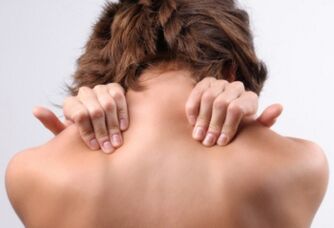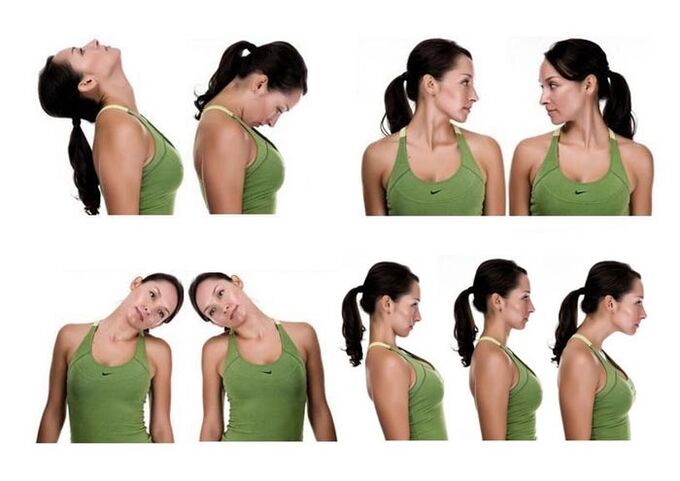
Some modern people have never heard of osteochondrosis. Most of them have experienced the symptoms of this disease several times. The widespread spread of the disease is associated with long sitting in front of a computer, passive lifestyle, improper diet, and others. Osteochondrosis of the cervical spine is indicated by pain, muscle weakness, limited mobility and a variety of other symptoms.
Do not ignore the signs of osteochondrosis, because the sooner you start treatment, the sooner you will get rid of the disease. In the early stages, conservative therapy is carried out: taking medications, exercise therapy, physiotherapy, massage, etc. When complications appear and destruction of the cartilage structure, surgery is prescribed.
What is this
Osteochondrosis of the neck is a pathology that occurs only in humans. Animals do not experience it. This is due to the vertical position of the spine. In this position, the vertebrae squeeze each other, which leads to the fact that the intervertebral disc is gradually destroyed.
The cervical region consists of 7 vertebrae, which are separated from each other by a disc. This segment of the spine is relatively mobile, which is why it is one of the most vulnerable areas of the spine. The weakest link in the cervical spine is the intervertebral disc, which primarily reflects degenerative-dystrophic changes.
The prevalence of cervical osteochondrosis is also explained by a weak muscular corset in the neck. In addition, small vertebrae are located in this area, they have different structures and fit too close to each other. That is why even a small load on the neck can trigger their displacement, as well as compression of blood vessels and nerve branches. When the vertebral arteries are pinched, which are located in the spine in this area, dangerous complications arise.
Osteochondrosis of the cervical spine (CS) threatens with protrusion (displacement of the nucleus pulposus without damaging the outer skin) and disc herniation. This formation compresses nerve bundles, blood vessels.
Due to degenerative changes in the intervertebral disc, the likelihood of the appearance of bone growths (osteophytes) in the vertebral joint area increases. Because of this, the intervertebral canal narrows and the neurovascular formation is compressed.
References. According to medical statistics, people over the age of 35 are more likely to develop cervical osteochondrosis. Although now there is pathological rejuvenation, which often develops in patients from the age of 20 years. This is due to an inactive lifestyle and poor diet.
Doctors identify 4 stages of pathology:
- 1 degree - the cartilaginous layer between the vertebrae begins to collapse. At this stage, the disease has extinguished the symptoms. Unfortunately, patients are not aware of it.
- 2 degrees - under vertebral pressure, the height of the disc decreases, the integrity of its outer shell is violated. At this stage, a bulge may appear. Pain appears, neck mobility is limited, and facial sensitivity may be impaired.
- Grade 3 - the bulge turns into a hernia, which narrows the blood vessels and muscles. In addition to the pain syndrome, there is pain in the back of the head, dizziness.
- 4 degrees - osteophytes are formed, which stabilize the vertebrae, but pinch the nerve fibers. The pain does not go away, stiffness of movement occurs, neighboring vertebrae are damaged, and neurological symptoms appear.
It is important to start treatment at stages 1 - 2 to avoid serious complications that can only be corrected with surgery.
cause
SHOP osteochondrosis is a complex and lengthy process that can occur under the influence of many negative factors.
For example, in the elderly, the disease is associated with age -related changes in the body. Then degenerative-dystrophic changes occur as a result of local circulatory disorders, metabolic processes, weakened immunity.
However, doctors identify the main causes of cervical osteochondrosis:
- Poor posture.
- The curvature of the spinal space.
- Injury of the cervical segment.
- Overweight.
- Exhausting physical work.
- Sitting for a long time in front of the computer.
- Passive lifestyle.
- Violation of metabolic processes.
- Frequent hypothermia in the neck.
- Improper bed organization (mattress too soft, pillows high).
- Frequent stress, chronic fatigue.
- Congenital pathology of the SHOP structure.
- Autoimmune diseases that cause cartilage degeneration.
- Infection.
- Characteristics of body parts, such as very long or short necks.
Under the influence of these factors, intervertebral structures, bone tissue begin to collapse, nerve bundles and blood vessels are damaged.
symptoms
The clinical picture of cervical spine osteochondrosis (OSHOP) is diverse. For this reason, it is difficult for patients to understand what is happening to them. They associate the early manifestations of the disease with overwork. And after the onset of obvious symptoms, they rush to the doctor, but in this case, irreversible changes are already there and it is impossible to restore the structure of the cervical spine.

The main symptoms of osteochondrosis of the cervical spine:
- Painful sensation in the neck, shoulders.
- Weakness of the muscles surrounding the affected spinal segment.
- Excessive sweating.
- Violation of upper limb sensitivity.
- Disorders of movement coordination.
- Cephalalgia (pain in the head).
- Vertigo (dizziness).
- Hearing and vision impairment.
- Increased blood pressure, etc.
The nature of headaches in osteochondrosis is different: paroxysmal, constant, throbbing, dull. This symptom manifests itself due to spasm of the cerebral vessels, compression of the nerve bundles of the cervical spine, and increased intracranial pressure.
With OSHOP, pain does not always appear in the area of the cervical segment, it can spread to the shoulders and arms. Discomfort can occur after sleep, sudden movements, neck tension, for example, when coughing or sneezing.
With SHOP osteochondrosis, pressure surges are observed depending on the time of day, persistent hypertension is not characteristic for the pathology. Usually, with increasing pressure, the following manifestations are observed: cephalalgia, pain in the hands, numbness of the cervical collar zone. A decrease in pressure is often observed after a prolonged nervous or muscular tension, uncomfortable posture.
Cervical osteochondrosis syndrome
Several syndromes (typical conditions accompanied by characteristic symptoms) are observed in OSHOP. Their manifestation depends on which nerve branch and channel is damaged.
Cervical osteochondrosis syndrome:
- Vertebral Arteries - occur as a result of compression or irritation of the arteries that feed the brain. Then the patient experiences hearing loss, vision impairment, dizziness, decreased pressure, migraines, etc.
- Heart - develops when the nerve bundles that invade the diaphragm or chest muscles are compressed. Then there is a burning pain in the chest, shortness of breath, weakness, increased heart rate.
- Hypertension - is caused by compression of the veins, which causes the outflow of blood from the head to be disrupted. Then the intracranial pressure increases, the patient experiences cephalalgia, nausea, vomiting.
- Cervical migraine - occurs as a result of compression of the nerves surrounding the vertebral arteries. Then there is a painful migraine -like pain in the back of the head. The attack lasts about 10 hours and is often accompanied by an eruption of vomiting.
- Radicular is the most common symptom complex in OSHOP. It is caused by compression of one of the nerve bundles in the vertebrae of the cervical segment. If the conduction of 1 - 2 roots of the cervical vertebrae is disturbed, sensitivity is disturbed or pain in the back of the head appears. If 3 pairs are damaged, the tongue becomes numb, the area behind the ears, it is difficult for a person to chew food. Inflammation of 4 pairs of roots is accompanied by pain in the collarbone, hiccups, difficulty swallowing. If the flow of 5 - 8 pairs of nerve bundles is disturbed, then it is difficult for the patient to move his hands.
References. Often, osteochondrosis of the cervical spine manifests itself in several complexes of symptoms at once, so the diagnosis is difficult. Therefore, you should not think about it yourself, it is better to contact a specialist.
Establish a diagnosis
If you do not know what to do when suspicious symptoms appear, then it is better to immediately contact a therapist. If necessary, the doctor will refer you to an orthopedist, vertebrologist, neurologist.
In diagnostic searches, the following instrumental studies are used:
- Radiography.
- Computed tomography or magnetic resonance imaging.
- Electroneuromyography.
All of the above studies provide some information about the cervical spine. For example, X-rays, CT, MRI are used to detect pathological changes in the structure of the spine. Electromyography allows you to assess the condition of nerve bundles.
With the help of radiography, carried out in different projections, it is possible to detect the accumulation of calcium salts, a decrease in the height of the cartilaginous spacer between the vertebrae, deformation of the CS, the presence of bone growth, etc. .
Treatment
OSHOP therapy must be thorough. Decisions about the choice of technique are made by the physician, taking into account the stage, form of the disease, and severity of symptoms.
The treatment of osteochondrosis of the cervical spine is long and complex. It is not possible to completely cure the pathology, especially when it relates to elderly patients. However, it is quite possible to stop degenerative-dystrophic disorders in the cervical segment at any stage.
In the early stages of the disease, conservative methods are used: medications, rehabilitation gymnastics, physiotherapy procedures, massage, orthopedic devices. Most of the above methods can be used at home.
At 3 - 4 stages, which are accompanied by destruction of not only the cartilage, but also the vertebral body, surgical intervention may be required.
The following medications will help relieve pain, inflammation, relieve tense muscles, and improve the condition of cartilage tissue:
- Pain reliever. If the pain is severe, you can help yourself by taking analgesic pills. For the same purpose, NSAIDs are used, which allow you to cope not only with pain, but also with inflammation.
- Steroids stop inflammation and pain. For this purpose, drugs based on glucocorticoids are used in the form of tablets or ointments.
- Muscle relaxation helps relax the cramped muscles around the affected area. For this purpose, solutions for parenteral administration based on glycerol or benzimidazole are used. They normalize muscle tone and relieve pain.
- Antispasmodics help fight muscle pain and cramps.
- Vitamins accelerate the recovery of the nervous system. For this purpose, drugs are taken based on the elements of groups B, A, C, D, E. The vitamin-mineral complex is quite effective.
References. If the pain syndrome is very severe, and oral analgesics do not help, then the doctor may prescribe therapeutic restrictions. Injections with the use of anesthetic solutions or steroids are placed directly into the pathological focus. This procedure can only be performed by an experienced technician.
As part of complex therapy, creams, gels, ointments with anti-inflammatory, warming, analgesic effects are used.
To alleviate the condition of the patients, to improve their physical fitness, therapeutic exercises are prescribed. Exercise helps strengthen the muscles around the neck, improve metabolic processes, speed up blood circulation, and relieve stress on a weak spine.
Gymnastics is very popular in OSHOP, which is usually carried out in gyms using special simulators. However, if you want, you can practice at home.

Complex exercise therapy for cervical osteochondrosis:
- Tilt your head smoothly to your shoulders, lock in for 30 seconds, then repeat the movement in the other direction.
- Tilt your head forward, try to touch your chin to your chest, then lift up and slightly forward.
- Lower your head slightly back, turn to the right, and then the left shoulder.
- Press your left shoulder with your right hand, lift your elbows slightly. Then turn your head to the right, linger, feel the muscle tension.
- This exercise is done like the third, only when turning your head, raise your hands above your head and connect them.
- Hands on your knees, spread them out, try to connect the shoulder blades, at the same time lift your chin. So you will list the thoracic area.
- Stand up, lower your arms, stretch your neck forward, try to touch your chin to your shoulders.
Before exercising, you need to do a joint warm -up and a bath to relax the muscles. After completing the complex, stretch.
You can treat osteochondrosis of the neck with the help of physiotherapy:
- UHF.
- Laser therapy.
- Magnetotherapy.
- Electrophoresis with drugs, etc.
Magnetotherapy relieves inflammation, pain. UHF and laser treatments speed up metabolism in the affected area, helping to eliminate swelling. Thanks to electrophoresis, the drugs penetrate the focus of inflammation through the skin, where it immediately shows its effect.
With the help of massage, muscle tone is normalized, blood flow to the damaged area is accelerated, and tissue trophism is improved. After completing the course, which usually consists of 10 procedures, the development of degenerative-dystrophic processes in the cervical spine stops.
At home, you can use a needle applicator - this is a plastic device with a large number of spikes. You need to lie on the device or apply it on the affected area. The applicator helps relieve pain, relax muscles, and improve blood circulation and movement.
Shants collars are used when severe pain occurs. This orthopedic device corrects the neck in the correct position, reduces the load on the vertebrae, and relieves pain.
With complex treatment, patients will be able to get rid of neck degenerative disc disease forever. However, this is possible if the disease is detected at stage 1. In other cases, complex measures will help stop the progression of the pathology.
Chondrosis of the cervical spine
Many people believe that chondrosis and osteochondrosis are one disease. However, this opinion is wrong. In the first disease, only the cartilaginous layer of the vertebrae is damaged, and in the second, degenerative changes spread to the bone tissue. That is, chondrosis is the first stage of osteochondrosis.
Cervical spine chondrosis develops when the metabolic processes of the intervertebral disc are disrupted. Then the collagen fibers are replaced with useless fibrous tissue, the hyaline cartilage becomes calcified and becomes less elastic. Its height decreases, which causes impaired vertebral function.
The causes of chondrosis and osteochondrosis are no different.
Cervical chondrosis has the following symptoms:
- Rapid fatigue in the muscles around the SHOP.
- Poor posture.
- Recurrent discomfort or mild pain in the affected area.
- Limited neck mobility.
As a rule, patients are not aware of the symptoms of chondrosis. The disease is detected incidentally, during an X-ray or MRI.
Chondrosis Treatment
The treatment plan for neck chondrosis is slightly different from the tactics of treating osteochondrosis. At the first disease, doctors prescribe NSAIDs and chondroprotectors. In addition, patients should avoid excessive physical exercise or prolonged sitting. It is recommended to do therapeutic exercises, eat properly, abandon bad habits.
Additional treatment methods include massage, manual therapy. In addition, physiotherapy procedures are indicated, for example, electrophoresis, ultraviolet irradiation, amplipulse therapy, diadynamic therapy, balneotherapy, mud treatment. Acupuncture (acupuncture) has proven its effectiveness in the treatment of chondrosis.
Reviews
In most cases, patients successfully relieve the symptoms of cervical osteochondrosis for a while, then the disease returns. This is usually due to the fact that patients seek medical help late or do not follow the doctor’s recommendations during treatment. But some have managed to cure OSHOP and no longer face its symptoms.
- "I was diagnosed with osteochondrosis of the neck in 2 stages. The doctor prescribed anti-inflammatory pills and injections. After the pain passed, I started going for massage, doing special exercises, and using medicated ointments. After undergoing treatment, I felt significant relief. However, after 3 months, the pain in the neck reappears. Therefore, the course should be started from the beginning. "
- "I have long had cervical osteochondrosis. From time to time I visit a chiropractor who fixes the vertebrae. But physiotherapy exercises help me the most. The doctor recommends some very effective exercises that I try to do every day. But, once I miss a few classes, the painstart over. "
- "Cervical osteochondrosis in the early stages is quite treatable. It happened to me. First, the doctor prescribed anti-inflammatory therapy, which relieves pain and inflammation. Then the treatment was supplemented with gymnastics, massage, acupuncture. In addition, I visited the pool, start taking vitamins, and eat properly. To forget the pain forever, I had to change my life completely. No day goes by without special training, but the advantage is that nothing hurts me, and my physical shape improves. I have long notfeel back pain and continue to lead a healthy lifestyle. "
The main conclusion
Osteochondrosis of the cervical spine is a dangerous disease that manifests itself in a variety of symptoms. The patient does not always understand what is really happening to him. And when severe pain appeared, she rushed to the doctor, but this sign indicates the presence of degenerative-dystrophic changes in the cervical segment. In this case, it is impossible to restore the condition of the spine. Then treatment is carried out, which helps stop the development of pathology and avoid serious consequences. Osteochondrosis therapy is a complex and lengthy process that requires patience and organization. After eliminating pain and inflammation, patients should regularly perform exercise therapy, attend massages, physiotherapy procedures, use orthopedic appliances, eat properly, and abandon bad habits. It is important to lead a healthy lifestyle, observe moderate physical activity, control weight, and monitor posture. Only in this case you will be able to stop the pathology and live a full life.

















































